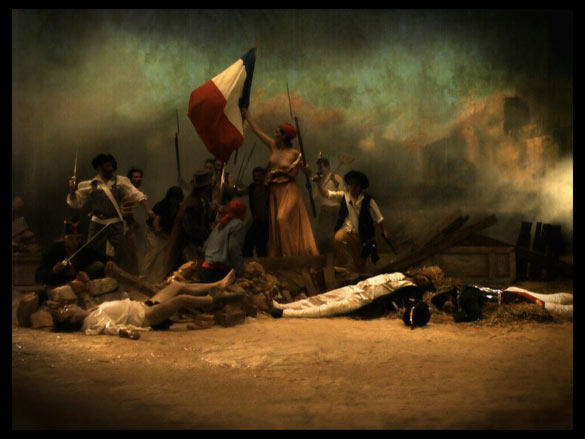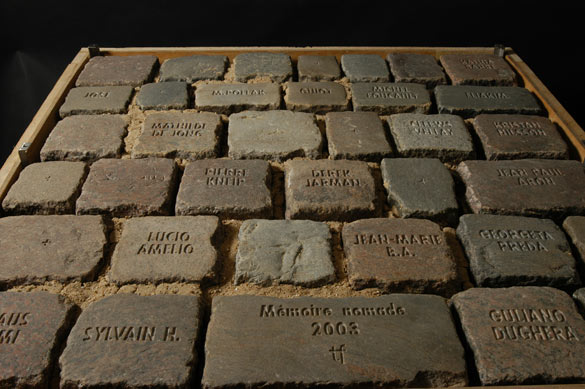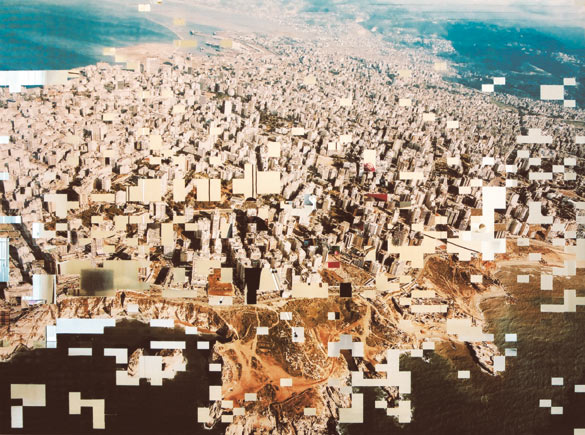Entretien avec Jean-Roch Bouiller

Inauguré à Marseille en juin dernier, le Mucem, Musée des civilisations de l’Europe et de la Méditerranée, joue l’intégration de l’art contemporain à des expositions directement liées à l’histoire et aux sociétés. Jean-Roch Bouiller, conservateur qui y est chargé de l’art contemporain, a bien voulu préciser les enjeux d’une telle association.
Lise Guéhenneux : Quelle est donc la place dédiée à l’art contemporain dans le projet de ce nouveau musée et, par conséquent, quel y est votre rôle ?
Jean-Roch Bouiller : J’ai surtout travaillé à l’exposition semi permanente de la galerie de la Méditerranée, avec Zeev Gourarier, le commissaire général de la galerie, et sur « Au bazar du genre » — qui présente une vingtaine d’œuvres contemporaines — en collaboration avec Denis Chevallier, son commissaire général. J’ai également travaillé à l’espace qui va être dédié à la création contemporaine dans le bâtiment Georges-Henri Rivière, sur la place d’armes du fort Saint-Jean. Mais le Mucem n’est pas un musée d’art contemporain ni un centre d’art. C’est un musée de société, de civilisation, donc plutôt un musée d’idées, autour desquelles la direction a la volonté d’essayer de réunir des regards multiples, contrairement à d’autres musées qui privilégient une seule approche, ethnologique, sociologique, celle des sciences humaines. La question de l’art contemporain arrive ainsi, c’est un regard qui est posé sur les questions que l’on aborde ici. On interagit à chaque fois de façon très différente, à la fois en matière de proportion et d’incursion dans le propos. Dans les quatre thématiques de la galerie de la Méditerranée, les œuvres viennent en contrepoint donner une dimension plus poétique, plus suggestive, qui permet de prendre un peu de recul par rapport au propos scientifique développé dans l’exposition. Au moment où l’on raconte une histoire de l’humanité, celle des sociétés méditerranéennes au début de la galerie, l’œuvre de Jean-Luc Vilmouth vient, par exemple, raconter l’histoire des origines d’une manière fantasmée, rêvée, pas du tout réelle mais qui est révélatrice de cette propension qu’ont les artistes à créer des univers. Soit on a cette approche-là, soit, comme dans le cas de Water Meter Tree de Sigalit Landau, on attire l’attention sur la dimension contemporaine du rapport à l’eau en Méditerranée avec l’œuvre d’une artiste qui met cette question au cœur de sa pratique.
Vous avez donc été intégré dès le départ au montage de ce projet ?
J-R.B : Oui, j’ai travaillé en lien étroit avec Zeev Gourarier, et avec toutes les personnes responsables des sections. La présence de la trentaine d’œuvres est le résultat d’un travail passionnant, de discussions constructives et d’argumentations, d’abord pour bien comprendre quel était le propos et pour ensuite essayer de faire des propositions d’œuvres pertinentes. On ne peut pas être un musée des civilisations aujourd’hui — surtout si on a une prétention transdisciplinaire, ce qui est notre cas — et ne pas tenir compte du fait que les artistes ont une vraie préoccupation sur la plupart des questions que nous nous posons en tant que scientifiques. Et puis, je pense que la façon de faire des expositions a beaucoup évolué ces dernières décennies et on aura beaucoup à y réfléchir dans notre pratique dans les années à venir. La dernière Biennale de Venise, par exemple, montre cette préoccupation avec de nombreux objets venant de l’ethnologie, de l’art brut. On perçoit un désir de ne pas avoir des univers clos et, au contraire, de se nourrir de ces confrontations : nous, nous sommes vraiment dans une configuration où la construction d’un matériel par la juxtaposition d’éléments provenant d’univers différents crée quelque chose d’un peu spécifique.

Tom Fecht. Torso, Fragment de la Mémoire Nomade Namen und Steine (Noms et Pierres), 2003. Granit, sable, bois / Granite, sand, wood. © MuCEM.
Vous êtes également associé aux expositions du Centre de conservation et de ressources ?
J-R.B : Oui. Avec la responsable du CCR, Émilie Girard, je travaille à une petite programmation qui est assez marginale, parce que dans un bâtiment qui reçoit moins de visiteurs, mais qui est importante intellectuellement et par rapport à l’histoire de cette collection. L’idée est d’inviter des commissaires extérieurs, des plasticiens, un chorégraphe, des collectionneurs, à revisiter les collections : un million d’objets dans les réserves font fantasmer ceux qui y ont accès et il règne une certaine nostalgie du musée national des arts et traditions populaires. Pour ce travail expérimental, on aimerait aussi développer une collaboration avec la Friche, qui est proche géographiquement. Pour la suite, les choses sont ouvertes.
Avez-vous une politique d’acquisition pour l’art contemporain ?
J-R.B : Ce ne sera pas prioritaire, plutôt au cas par cas, et on verra si de cela naît quelque chose de cohérent. Je pense déjà à certaines œuvres en prêt ou en dépôt dans la galerie mais on travaille avec des institutions dont c’est la vocation et qui nous ont déposé des œuvres, tels le FNAC, le MNAM, le Frac PACA, le CIRVA et le CNHI qui a constitué une collection contemporaine assez riche et avec qui nous travaillons en étroite collaboration — notamment en ce moment à l’organisation d’un séminaire à propos de l’art contemporain dans les musées de civilisation.
Qu’est-ce qui vous a fait plaisir à l’ouverture ?
J-R.B : Lorsque l’on a allumé la pièce en néon de Vilmouth, lorsque le Jardin d’addiction de Berdaguer et Péjus a pris place à un endroit clé de la galerie. Ensuite, il y a des doutes, la pièce de Sigalit Landau y a sa place conceptuellement mais on aurait peut-être pu mieux la présenter ; peut-être aussi que les vitrines de l’œuvre de Pistoletto qui sont identiques à celle du reste de la scénographie entretiennent une confusion… Mais c’est normal, cela ne veut pas dire que nous sommes mécontents du résultat, simplement que nous continuons à avoir un regard critique.

Cristina Lucas. La Liberté raisonnée, 2009. Vidéo. © Cristina Lucas.
Que souhaitez-vous pour l’avenir ?
J-R.B : Continuer ce travail de « tricot » dans les expositions du J4 en fonction des projets et de la volonté des commissaires ; continuer aussi à collaborer avec Emilie Girard au CCR et, surtout, œuvrer à la mise en place de cet espace du fort Saint-Jean dédié à la création contemporaine. Trois axes de programmation ont été définis pour lui : un axe géographique de recherche, dans les pays de la Méditerranée, des zones où se trouvent des foyers de création intéressantes pour notre propos, où les artistes sont engagés dans la société ; un axe thématique sur la question « art et société » (Comment la création contemporaine peut-elle avoir une incidence sur la vie ?) qui permettra des interactions avec le design, l’architecture, la mode, etc. ; et un troisième axe que l’on aimerait approfondir en particulier et qui est celui de l’image, de sa présence dans la société contemporaine. Comment les artistes s’en saisissent-ils et peuvent-ils en faire une analyse critique ? Nous souhaitons faire de cet espace de trois cents mètres carrés un lieu où l’on réfléchit à des questions spécifiques à un musée de civilisation comme le nôtre.
Jean-Roch Bouiller in conversation with Lise Guéhenneux
The brief of the MuCEM (Museum of European and Mediterranean Civilizations), which was opened in Marseille last June, is to incorporate contemporary art in exhibitions directly linked with history and societies. The curator Jean-Roch Bouiller, who is in charge of contemporary art at the museum, has kindly talked about the challenges of this kind of association.
Lise Guéhenneux : So what is the place dedicated to contemporary art in the project of this new museum and what, consequently, is your role in it?
Jean-Roch Bouiller : Above all I’ve been working on the semi-permanent exhibition in the Mediterranean gallery, with Zeev Gourarier, the gallery’s general curator, and on “Au bazar du genre” (“The Genre Bazaar”)—which is presenting some twenty contemporary works—in collaboration with Denis Chevallier, the general curator of this show. I’ve also been working on the space to be dedicated to contemporary creation in the Georges-Henri Rivière building, on the Place d’Armes in the Fort Saint-Jean. But the MuCEM is neither a contemporary art museum nor an art centre. It’s a museum of society and civilization, so rather a museum of ideas, around which the management wants to try and bring together many different ways of looking at things, unlike other museums which encourage a single approach, be it ethnological, sociological, or focused on the humanities. This is how the contemporary art issue comes into the picture, it’s a way of looking that is focused on the issues being broached here. Each time we interact in a very different way, both in terms of proportion, and intrusion into the idea. In the four themes of the Mediterranean gallery, the works offer a counterpoint, lending a more poetic, more suggestive dimension, making it possible to stand back a little in relation to the scientific idea being developed in the exhibition. At a moment when we’re recounting a history of humanity, the work of Jean-Luc Vilmouth, for example, recounts the history of origins in a fantasized, dreamy way, not at all real, but revealing this propensity artists have to create worlds. Either you have this approach or, as in the case of Sigalit Landau’s Water Meter Tree, you attract attention to the contemporary dimension of the relation to water in the Mediterranean with the work of an artist who puts this issue at the heart of his praxis.
So you’ve been included from the outset in setting this project up?
J-R.B : Yes, I’ve been working closely with Zeev Gourarier, and with all the people in charge of the various sections. The presence of some thirty works is the result of an extremely interesting project, constructive discussions and arguments, first to properly understand what the idea was and then try and come up with pertinent proposals for works. You can’t be a museum of civilization these days—above all if you make trans-disciplinary claims, which is our case—and not take into account the fact that artists are really concerned about most of the issues that we are raising as scientists. And then I think that the way of putting on shows has evolved a lot over the past few decades and there’ll be lots for us to think about in our praxis in the years to come. The last Venice Biennale, for example, shows this concern with many objects coming from ethnology and art brut. You can see a desire not to have closed worlds and, on the contrary, to be nurtured by these confrontations: we are really in a configuration where the construction of something using the juxtaposition of elements coming from different worlds creates something a bit specific.

Hadjithomas & Joreige. Circle of confusion, 1997. © Courtesy Galerie In situ – Fabienne Leclerc, Paris.
You’re also associated with the exhibitions at the Centre for Conservation and Resources?
J-R.B : Yes, with the head of the CCR, Emilie Girard, I’m working on a small programme which is quite marginal, because it’s in a building which has fewer visitors, but is important both intellectually and in relation to the history of this collection. The idea is to invite outside curators, visual artists, a choreographer, and collectors to re-visit the collections: a million objects in the reserves make those with access to them fantasize, and there’s a certain nostalgia for the National Museum of Arts and Popular Traditions. For this experimental work, we’d also like to develop a collaboration with La Friche, which is geographically nearby. As for what happens after that, things are open.
Do you have a contemporary art acquisitions policy?
J-R.B : This won’t be a priority, rather on a case-by-case basis, and we’ll see if this gives rise to something coherent. I’m already thinking of certain works on loan or on permanent loan in the gallery, but we’re working with institutions whose brief is precisely this, and who have loaned us works, like the FNAC, the MNAM, the FRAC PACA, the CIRVA and the CNHI, which has put together a fairly rich contemporary collection, and with whom we work in close collaboration—especially right now, organizing a seminar on contemporary art in museums of civilization.
What did you like about the opening?
J-R.B : When they lit up Vilmouth’s neon piece, and when Berdaguer & Péjus’s Jardin d’addiction took its place in the key spot in the gallery. Then there are doubts: Sigalit Landau’s piece has its place conceptually, but we could possibly have presented it better; perhaps, too, the museum display stands for Pistoletto’s work, which are identical to those in the rest of the set, cause confusion… But that’s normal, and it doesn’t mean that we’re unhappy with the outcome, simply that we still have a critical eye.
What do you want for the future?
J-R.B : To carry on this task of “knitting” in the J4 exhibitions based on the curators’ projects and wishes; also to carry on working with Emilie Girard of the CCR and, above all, work on the establishment of this space in Fort Saint-Jean dedicated to contemporary creation. Three programme themes have been singled out for it: a geographical theme of research, in the Mediterranean countries, involving zones where there are hubs of creation of interest to our project, where artists are involved in society; a theme about the issue “art and society” (how can contemporary art have an effect on life?) which will permit interactions with design, architecture, fashion, and the like; and a third theme that we’d like to develop in particular which is that of the image, and its presence in contemporary society. How are artists grasping imagery, and can they make a critical analysis of it? We want to make this 300 sq.m. venue a place where people think about issues specific to a museum of civilization like ours.
articles liés
Céline Ghisleri
par Juliette Belleret
Claire Staebler
par Patrice Joly
Arnaud Dezoteux
par Clémence Agnez

